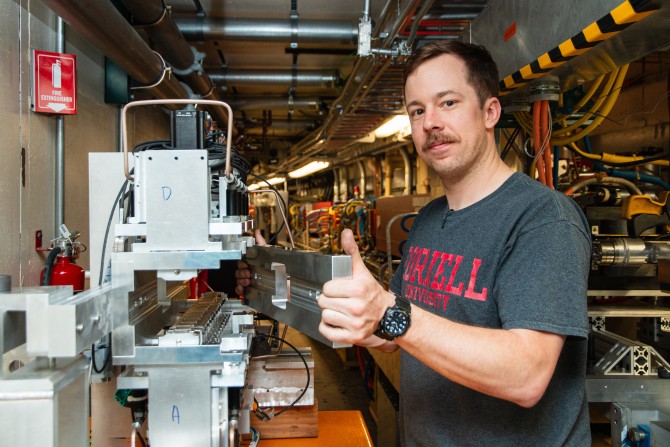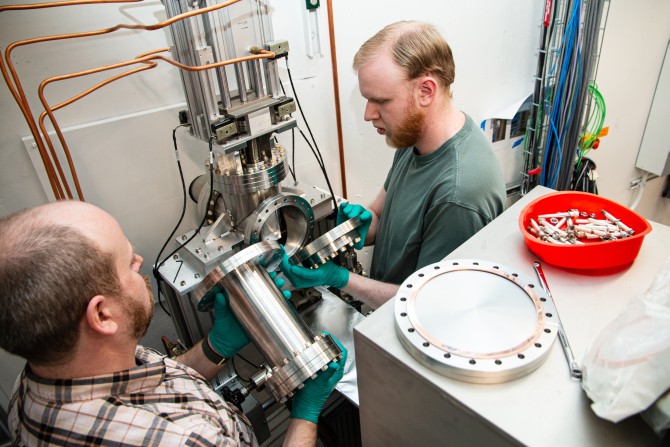While the particle accelerator buried beneath Cornell's soccer field typically hums along 24 hours a day, 7 days a week, the spring down period offers a rare and essential pause in operations. For two weeks, the Cornell High Energy Synchrotron Source, CHESS, powers down-giving technical staff, scientists, and engineers a valuable window to dive into hands-on work that's impossible when the machine is running.
"We are bringing very strong attracting magnets within ~150 microns of the thin wall section on both sides of the beam pipe. Misalignment could mean crushing/ piercing the chamber and that's how you make a lot of people upset in a hurry." - TJ Joyce, CHESS Research Support Specialist.
This spring, teams installed specialized X-ray mirrors and a phase plate system for the new High Magnetic Field (HMF) beamline, carried out ultra-high vacuum work in the experimental cave, replaced aging plumbing and magnet arrays in the accelerator tunnel, and test-fitted a prototype compact wiggler-advancing both short-term reliability and long-term innovation at CHESS.
"It's a very busy time," says Katie Moring, CHESS Operations Manager. "There's a lot of work we can't do when the machine is running-like anything in the tunnel, on the cooling systems, or on the personnel protection systems-so we save all that for these short down periods."
A major focus this spring was the HMF beamline, funded by the National Science Foundation, which will combine state-of-the-art X-ray techniques with persistent high magnetic fields to create a first-of-its-kind facility to tackle fundamental questions about the nature of matter. Staff successfully brought X-rays into the HMF cave earlier this year-a critical milestone-and used the spring shutdown to make a significant push toward hosting first users, expected in early 2026.
"Excitement is building up for this new facility," said Louise Debefve, lead scientist on the HMF beamline. "Both internally, as we are all eager to see this years-long project come together, but also in the broader x-ray and high magnetic field communities."
Will Foschi stands in front of HMF's open phase plate system. This system is typically bolted shut using the five-dozen bolt holes on its rim.
Over the two-week period, CHESS staff worked closely with engineers from Oxford Instruments to install key optical components at the beamline, including precision X-ray mirrors, and to improve the double crystal monochromator (DCM)-a crucial device that selects and transmits the specific X-ray energies needed for experiments.
Engineers also installed and calibrated the HMF phase plate system, a highly sensitive component that adds a new capability by manipulating the polarization of X-rays passing through a sample. This system, used in combination with the high magnetic fields, will allow for a better understanding of magnetic properties at the atomic level.
Down the beampipe in the HMF cave, CHESS research support specialists Gregg McElwee and Ryan Ford led ultra-high vacuum (UHV) work on the mirror chamber, which will enable precise horizontal and vertical X-ray focusing.
But installing the mirrors wasn't as simple as bolting parts together. "Vacuum pressures in this part of the beamline reach 1e-8 torr-about 100 billion times lower than atmospheric pressure," said McElwee. "To maintain that, every component has to be meticulously cleaned, baked, and installed with minimal exposure to air. It's exacting work, but satisfying when everything seals up properly."
CHESS research support specialists Gregg McElwee and Ryan Ford led ultra-high vacuum (UHV) work on the mirror chamber, which will enable precise horizontal and vertical X-ray focusing.
Elsewhere in the accelerator tunnel, crews tackled a range of essential maintenance projects. They replaced decades-old plumbing in sector seven, inspected and surveyed key magnets and beamline components, and swapped out aging undulator magnet arrays to ensure top performance when operations resume.
Another ambitious project involved the test installation of a prototype compact wiggler-an advanced magnetic device designed to generate X-rays for CHESS. While not yet in use by researchers, the prototype is helping engineers study its effects on CESR operations and prepare for a more space-efficient version to replace the current wiggler in that sector.
"This prototype is two to three times smaller than what we eventually hope to install," said TJ Joyce, CHESS insertion device support specialist. "But getting it into position wasn't easy. We're working with incredibly strong magnets and clearances within 150 microns of a thin vacuum chamber wall. One misalignment and you could crush the beam pipe."
Despite the complexity and pressure, CHESS teams pulled off another successful spring down period through close collaboration and careful planning. Thanks to their efforts, the beamlines will be ready when users return on April 23-primed to deliver high-energy X-rays to researchers from around the world.









